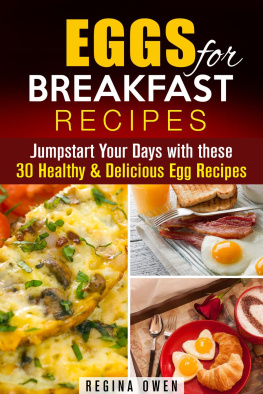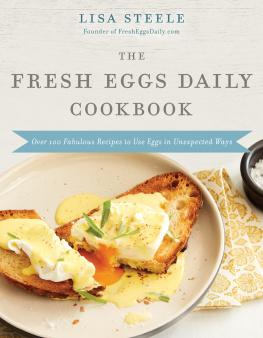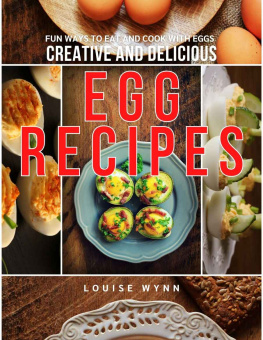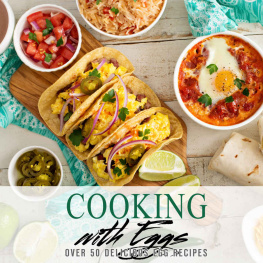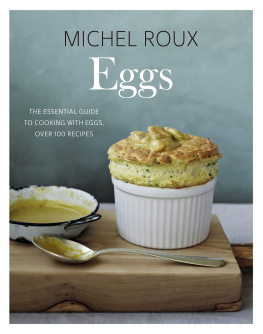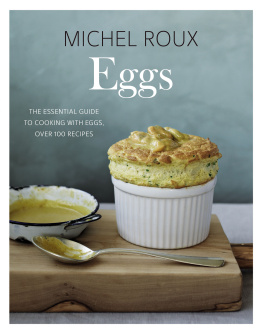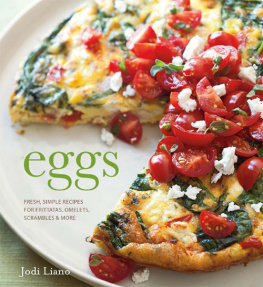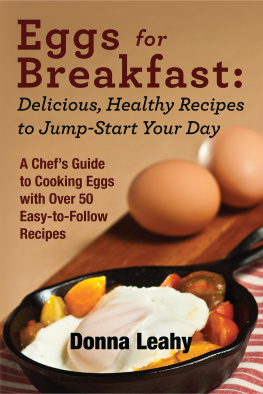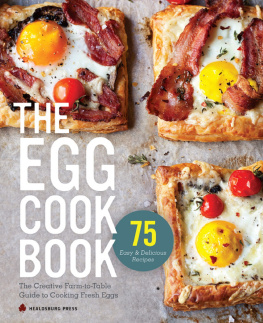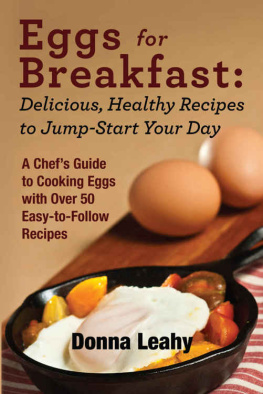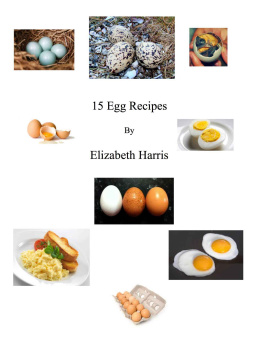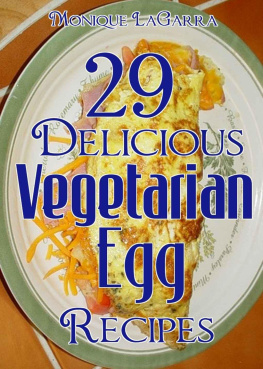

FOR LYLE
My sincerest thanks to the following:
The team at Chronicle, especially editor Amy Treadwell and designer Sara Schneider, for taking my words and recipes and turning them into this beautiful book.
David Reamer, Im so glad we were able to work together on this; your photos are as gorgeous as can be.
Anne Parker, your home provided an inspiring set for the photo shoot, and your lovely prop styling makes me want to jump into each scene and eat a plate of eggs.
Lisa Ekus and Sally Ekus, for enthusiastically agenting this project.
My favorite chicks, Caroline Ford, Lila Martin, and Nicole Furtaw, for your helpful advice, recipe testing, and, most important, your friendship while I was writing this book and always.
Diane Morgan, Im so grateful for your continued friendship and guidance.
Mom, Dad, Allison, and Thomas, for your love, interest, and support in everything I do.
My love, Lyle Railsback, for bearing with me through the messy kitchen, late nights, and many consecutive dinners of eggs on top of things.
Finally, thank you to all the people raising hens in humane ways, providing us with delicious eggs to cook and enjoy.
Text copyright 2014 by Andrea Slonecker.
Photographs copyright 2014 by Chronicle Books LLC.
All rights reserved. No part of this book may be reproduced in any form without written permission from the publisher.
Library of Congress Cataloging-in-Publication Data:
Slonecker, Andrea.
Eggs on top: recipes elevated by an egg/by Andrea Slonecker.
pages cm
Includes index.
ISBN 978-1-4521-2368-4 (pb)
ISBN 978-1-4521-3040-8 (epub, mobi)
1. Cooking (Eggs) I. Title.
TX745.S55 2014
641.6'75dc23
2013026596
Designed by
sara schneider
Photographs by
David L. Reamer
Prop styling by
anne parker
Food styling by
andrea slonecker
Chronicle Books LLC
680 Second Street
San Francisco, California 94107
www.chroniclebooks.com
INTRODUCTION
Knowing how to properly prepare eggs will make you a better cook. In fact, the one hundred crisp pleats in a chefs tall white toque are said to represent the number of egg dishes in his repertoire.
The magic of egg cookery is one of the great culinary marvels. The eggs versatility as a liquid that readily transforms to a solid with relatively brief exposure to heat makes it an indispensible ingredient in kitchens all over the world.
Yet eggs are also one of the most undervalued foods, their meal-making capabilities often overshadowed by meat outside of the morning hours. Even though eggs are a part of everyones standard grocery list, sometimes we forget, or dont realize, that sliding a sunnyside up egg onto a plate of steamed rice or sauted vegetables can transform a side dish into an entre, with a sauce built right in.
In terms of their nutrient density and their satisfying flavor and richness, eggs are one of natures most perfect foods. Especially when you consider how economical it is to put this protein on the table. Indeed, even most highquality, organic, free-range, vegetarian, farmfresh eggs factor out to no more than sixty cents apiece.
Every Saturday I buy my eggs for the week at the Portland Farmers Market. I can count on seeing Marvin Kosmals folding table each week, haphazardly stocked with eggs from the hens, ducks, quail, and geese raised on his Dancing Chicken Farm in La Center, Washington, just across the Columbia River. I can tell from his photo books of his birds and their stomping groundsa brooder, green pastures, and the nesting coopthat they sure have reason to dance. And proof is in the eggs: They are exceptionally fresh, usually harvested that morning or the day before he brings them to market.
Sometimes out of convenience, I buy eggs at my neighborhood grocery store, and those are quite good, too. With our increasing demand for high-quality eggs from humanely raised hens, the choices at supermarkets are changing for the better.
Whats in This Book?
First I divulge classic and clever new techniques for cooking eggs of the chicken, duck, and quail varieties. The second half of the book provides recipes for dishes that are enhanced by eggs, from reimagined classics to new ideas full of worldly flavors, including quick-fix lunches, simple weeknight suppers, and sophisticated weekend brunches and dinners. Armed with this knowledge, a fast, inexpensive meal is always possible, because, heck, who doesnt have an egg on hand?
Eggs to Infinity, and Beyond
Ive barely scratched the surface here, because the possibilities are endless. If theres one goal I have for this book, its to inspire you to search out the freshest, best-quality eggs you can find and to cook them in new ways you never thought possible. Get cracking!
an EGG primer
Is there a protein on Earth that cooks more quickly than an egg? Egg yolks and whites coagulate, or set, at two different temperatures, allowing for fully cooked whites and undercooked yolks. So we are able to cook eggs with two distinctly different textures in one nifty little package. But we must be careful, because excessive coagulation happens fast, pushing moisture from the eggs, which leaves them dry and unremarkable.
The focus of cooking eggs just right is mostly in the doneness of the yolks. Most of us are quite opinionated when it comes to the degree to which we like our egg yolks to be cooked: Some like runny, saucy, totally liquid yolks; some, like me, prefer the yolks to be a bit thickened but still loose and oozy, which I refer to as molten yolks in this book. Still others are completely freaked out by a loose yolk and like them cooked until firm, or hard-cooked.
I hope you will see that all these degrees of doneness have their place. Sometimes a liquid yolk is used like a sauce, to moisten the food that the egg is placed atop. But if the eggs are baked in a sauce or liquid or placed over a dish that is already quite moist, the egg yolks are best when they are molten. Because a completely runny yolk would get lost, the slight variation in texture is nice. Firm yolks are great for deviled eggs, or when the egg adorns a cold salad.
CRACKING THE EGG
Its best to gently tap the center of the egg against a hard, flat surface, like a countertop, rather than the edge of a bowl or pan, because it helps to prevent bits of shell from getting into the eggs. And crack the eggs into a small bowl before slipping them into a pan or baking dish. This gives you the chance to inspect for bits of shell, blood spots, or broken yolks. Save eggs with broken yolks for scrambling.
SEPARATING YOLKS FROM WHITES
To separate the yolk from the whites, crack an egg over a small bowl and pass the yolk back and forth between the shell halves, allowing the whites to fall into the bowl. Another method is to crack the egg into your hand and gently pass the yolk back and forth as the whites slip through your fingers. I like that one the best. If youll be whipping the whites for something like a meringue, be sure not to dribble any of the yolk.
KINDS OF EGGS
Hen eggs are by far the most widely consumed eggs in the world. In the recipes in this book, it is assumed that you will be using an egg from a hen (female chicken), unless another egg is called out. Duck eggs can be used interchangeably with chicken eggs; they just take a little longer to cook. I do hope you will use duck eggs if you can find them at a farmers market or specialty grocery store. The richness of a duck egg is remarkable when gently cooked, as with poaching and soft cooking in the shell. They add extra va-va-voom to nearly any dish in this book.
Next page

